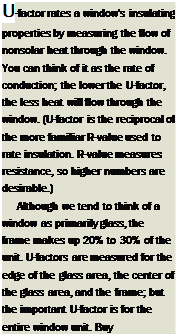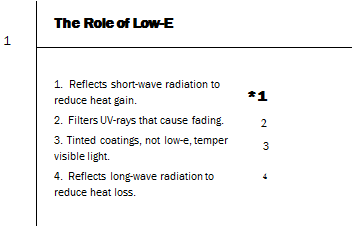Insulated Glass Reduces Heat Loss
Manufacturers typically refer to glass as glazing. Using glazing as a noun is a bit pretentious, like referring to a window as a fenestration, but it does give the sense that glass assemblies in today’s windows are a far cry from the single-pane windows installed in the 1970s.
Those single-pane windows have been abandoned in most heating climates because glass is a horrible insulator. A standard window today relies on an insulated glass unit (sometimes called an IG). This unit is a sealed sandwich of two or three pieces of glass with an airspace between the panes. IG units are manufactured by a few glass companies that supply the hundreds of window manufacturers in North America.


 ing decisions should be based on this number, which appears on the NFRC label (above).
ing decisions should be based on this number, which appears on the NFRC label (above).
U-factors for operable windows range from 0.14 for a superinsulating suspended-film unit to 0.5 or so for a basic double-pane window from a big-box store. Lower U-factors correlate with higher prices.
The airspace between glass panes, usually V2 in. to 2/з in. thick, serves as insulation by reducing the transfer of heat through conduction. A single clear pane has a U-factor of 1.04, but a sealed double-pane unit has a U-factor of 0.5 (see "What’s a U-Factor?" above). Adding a third pane improves the U-factor to 0.3.
Replacing the air with gas improves the insulating value of the window. Manufacturers use argon or krypton gases because they’re inert—chemically stable and nonreactive— and because they reduce heat loss, as they are less conductive than air. Argon and krypton also reduce convective losses because the gases are heavier than air, reducing gas movement within the insulating space.
Krypton performs slightly better than argon, but its bigger advantage is that the optimal spacing between krypton-filled panes is narrower than what’s required for argon. That means less stress on the sashes, particularly in triple-pane windows.
Spacers Are Potential Weak Points
Spacers between glass panes perform three functions: They maintain a uniform separation between pieces of glass, they provide a good adhesive surface for the glass, and they create an airtight seal for the insulating cavity.
Although you should choose windows based on their overall performance ratings, the spacer, while small, substantially impacts a window’s U-factor and condensation resistance.
The spacer’s job is complicated by the fact that it’s in contact with both the inside and outside surfaces of the window, forming a bridge between indoor and outdoor environments. Because the spacer is more conductive than the air or gas fill, it changes the temperature of a 21/2-in.-wide band around the edge of the glass. As a consequence, the window’s overall U-factor is affected. In smaller windows, the 21/2-in. temperature band is a larger percentage of the window and has a greater effect on the window’s U-factor. While spacers can be considered the Achilles’ heel of all windows, a casement window performs slightly better than a double-hung of the same size because the former has less spacer area. Likewise, the thermal performance of true divided-lite windows made up of multiple IG units suffers because of all the spacer area in the window. (Simulated divided lites can also affect U-factor if the grille creates a thermal bridge between the panes.)
Spacers are made of aluminum, steel, fiberglass, foam, and thermoplastics, often in some combination. Foam spacers have the lowest U-factor, while aluminum has the highest. Today, quality windows use "warm – edge" spacers. (It’s worth noting that warm – edge means only that it’s less conductive than aluminum.) A good warm-edge spacer raises the interior surface temperature of the glass along the perimeter of the window.
This is especially important at the window’s
 bottom edge, which is most subject to condensation. At 0°F outside, a good spacer increases the temperature at the bottom of the inside glass pane by 6°F to 8°F. As a result, a more comfortable relative-humidity level indoors is possible during the winter without window condensation.
bottom edge, which is most subject to condensation. At 0°F outside, a good spacer increases the temperature at the bottom of the inside glass pane by 6°F to 8°F. As a result, a more comfortable relative-humidity level indoors is possible during the winter without window condensation.






Leave a reply